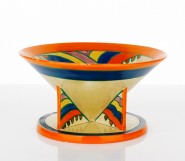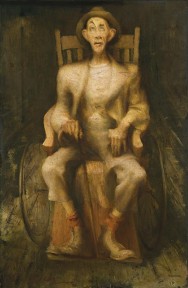Lot #32 - Eric Wilson
-
Auction House:Deutscher and Hackett
-
Sale Name:Part 1: Important Australian & International Fine Art
-
Sale Date:27 Nov 2013 ~ 7pm
-
Lot #:32
-
Lot Description:Eric Wilson
(1911 - 1947)
The Inmate, 1944
oil on board
47.0 x 31.0 cm
signed and dated lower left: Eric Wilson / 44 -
Provenance:Artarmon Galleries (Artlovers), Sydney (label attached verso); Sotheby's, Sydney, 13 October 1983, lot 27; Holmes à Court Collection, Perth; Deutscher~Menzies, Melbourne, 20 August 2001, lot 35; The Hicks Family Collection, Melbourne
-
References:RELATED WORKS: The Inmates, 1944, oil on composition board, 50.2 x 38.1 cm, collection of the Art Gallery of New South Wales, Sydney; Studies of Old Men, 1942, six pencil drawings on ruled paper, 10.5 x 12.5 cm (approx.) each, collection of the Art Gallery of New South Wales, Sydney
-
Notes:Exaggeration is as much a part of great art as idealisation. Look at the idealised works of the Italian Renaissance masters or the elongated figures of El Greco. Rembrandt and Goya employed distortion to plumb the depths of humanity, and Vincent van Gogh gave his paintings emotional impact through the impassioned manipulation of paint and colour. Distortion is part of creativity. In Australia this achieved a new height in 1944 with William Dobell's masterpiece, Portrait of an Artist (Joshua Smith), the most famous painting in the country at the time, furthered by the daily drama of the unsuccessful court case which tried to deny it the Archibald Prize. Eric Wilson's The Inmate belongs to this same genre and period. Painted in the same year as his friend Dobell's portrait of Joshua Smith kept the nation agog, Wilson employed distortion for arresting effect in the expression of his deeply felt, humane concern. Wilson worked as a ward attendant in the Lidcombe State Hospital from 1942 to 1944. Grossly overcrowded, the conditions in this geriatric hospital were appalling. Patients were afflicted with terminal diseases or advanced senility. Food, clothing and lighting were inadequate, the 1943 inquiry labelling sections 27 and 28 'horror wards'. Another Wilson painting, The Inmates, was based on the notorious ward 27, and The Inmate most surely represents one of its relics of humanity. In these paintings Wilson emphasised the frailty and decrepit state of the old men, calling upon a number of studies he made of the tragic inhabitants. He deliberately chose this Mannerist style in order to communicate all the more powerfully the horrors witnessed, the pathos and tragedy that surrounds the forgotten at life's end. As in Dobell's portrait of Joshua Smith, Wilson employed distortion and elongation to give his painting its disturbing psychological and physical impact. The cadaverous bones pressing through the thin clothing speak of approaching death. Stupefaction, incomprehension flickers across the face through the asymmetry of its features. The transfixed stare and skeletal hands add to its spectral presence, the sense of isolation furthered by the haunting light and limited colour scheme. Wilson was a highly gifted artist, working in both a realist and cubist style, as seen in those portraits of his mother in the collections of the National Gallery of Victoria and the Newcastle Region Art Gallery. In The Inmate he chose the Mannerist mode in plumbing the depths of his social conscience to create this uncompromising and poignant confrontation. DAVID THOMAS
-
Estimate:A$30,000 - 40,000
-
Realised Price:
-
Category:Art
This Sale has been held and this item is no longer available. Details are provided for information purposes only.










